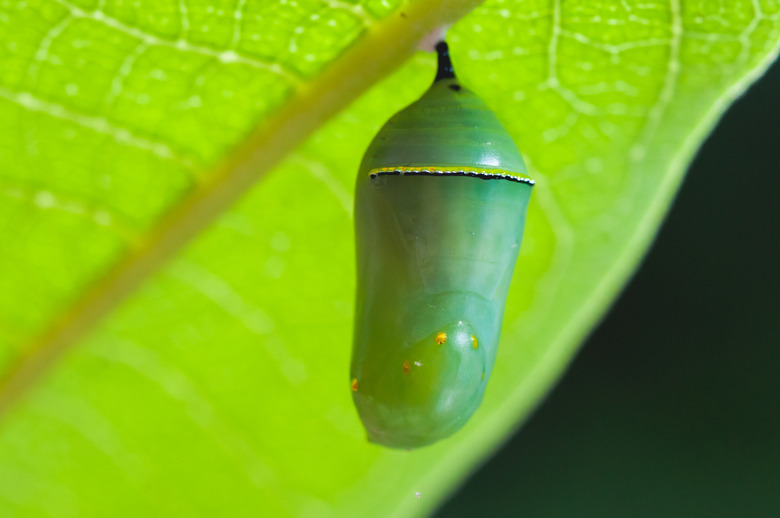How To Know If A Caterpillar In A Cocoon Is Dead
It's practically a right of passage to raise a monarch butterfly from an egg into a fully-formed adult. You can find a number of educational butterfly-raising kits online and many schools use these kits while teaching kids about the life cycle of a butterfly or moth.
However, sometimes things don't quite go as planned and your butterfly doesn't emerge when it should. To understand if your chrysalis is dead, you should understand the life cycle of the butterfly and moth first.
The Life Cycle of a Butterfly or Moth
The Life Cycle of a Butterfly or Moth
All moths and butterflies go through a four-stage life cycle. The life cycle begins with an egg. That egg eventually hatches into a larva, known as a caterpillar. In this stage, the caterpillar eats voraciously and grows incredibly quickly. Once it's stopped growing, the caterpillar then enters the pupa stage.
In the pupa stage, the caterpillar of a butterfly creates a chrysalis and the caterpillar of a moth creates a cocoon. The amount of time a caterpillar remains in the pupa stage varies based on the species. Some species, such as the beet army worm, spend just four days in the pupa stage. Other species, such as the monarch butterfly, can spend nearly two weeks in the chrysalis form.
How to Know if a Caterpillar in a Cocoon is Dead
How to Know if a Caterpillar in a Cocoon is Dead
To better understand if a caterpillar in a cocoon is dead, you must know what species you are working with and how their development typically occurs. Different species remain in the chrysalis for different periods of time and require different temperatures to hatch. Pupa of different species also have different colorations.
For example, the pupa of the monarch butterfly is typically green in color. However, the chrysalis begins to darken as it nears the time it will emerge. If your monarch butterfly chrysalis begins to turn black, you shouldn't be too concerned unless that stage lasts longer than a few days.
The chrysalis should become transparent as the time to emerge nears. If your chrysalis remains black and your butterfly does not emerge, very gently bend it. If it remains bent, it is likely dead and you should discard it to prevent disease from spreading to the other caterpillars.
What Causes Caterpillar Death in Cocoons?
What Causes Caterpillar Death in Cocoons?
A number of different ailments can cause a caterpillar in a cocoon to die. These can vary from parasites to bacterial infections or viruses. Some of the common afflictions that can kill in the pupa stage include:
- Black Death – Despite having a singular name, people use this term to describe two different diseases. The first is a bacteria in the Pseudomonas family. The second is a virus known as nuclear polyhedrosis virus. Pupa afflicted with this illness will turn black and begin to liquify inside.
- Tachinid Fly Infestation – When pupa infested with this parasite die the worms of the fly emerge from their chrysalis. You will also see white strands of silk hanging from the chrysalis.
- Chalcid Wasp Infestation – These wasps wait for the chrysalis to form and then lay their eggs inside. This infestation is fatal to the chrysalis. You will be able to see numerous black dots on the surface of the chrysalis from where the wasps deposit their eggs.
- Various Toxins or Poisons – Caterpillars can come in contact with a number of different toxins. Pesticides and other chemicals can kill a caterpillar in the larva or pupa stage. Flea and tick medications for your pets can also kill caterpillars or pupa, so use caution if you have recently applied these medications to your dog or cat.
References
- University of Nevada, Reno: Life Cycle of the Butterfly or Moth
- United States Forest Service: Monarch Butterfly Frequently Asked Questions
- Save Our Monarchs: Common Monarch Ailments 101
- Monarch Butterfly Life: Monarch Chrysalis Problems, Surprising Solutions, and Normal Development
- Pets on Mom.com: What Does it Mean When a Butterfly's Cocoon Turns Black?
Cite This Article
MLA
Zinni, Yasmin. "How To Know If A Caterpillar In A Cocoon Is Dead" sciencing.com, https://www.sciencing.com/how-to-know-if-a-caterpillar-in-a-cocoon-is-dead-12505822/. 2 November 2021.
APA
Zinni, Yasmin. (2021, November 2). How To Know If A Caterpillar In A Cocoon Is Dead. sciencing.com. Retrieved from https://www.sciencing.com/how-to-know-if-a-caterpillar-in-a-cocoon-is-dead-12505822/
Chicago
Zinni, Yasmin. How To Know If A Caterpillar In A Cocoon Is Dead last modified August 30, 2022. https://www.sciencing.com/how-to-know-if-a-caterpillar-in-a-cocoon-is-dead-12505822/
